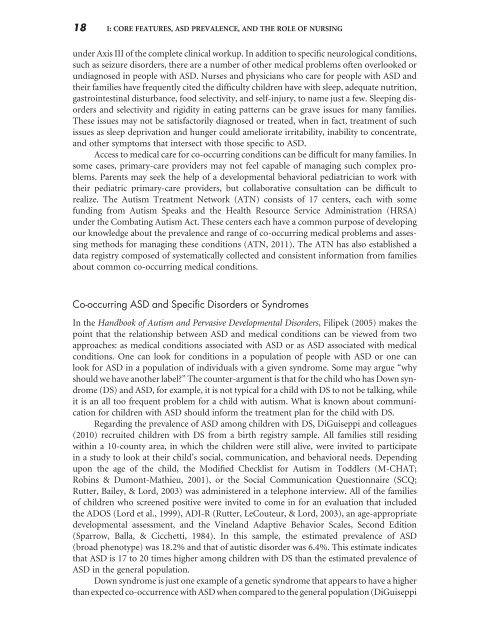Nursing of Autism Spectrum Disorder - Springer Publishing
Nursing of Autism Spectrum Disorder - Springer Publishing
Nursing of Autism Spectrum Disorder - Springer Publishing
You also want an ePaper? Increase the reach of your titles
YUMPU automatically turns print PDFs into web optimized ePapers that Google loves.
18 I: CORE FEATURES, ASD PREVALENCE, AND THE ROLE OF NURSING<br />
under Axis III <strong>of</strong> the complete clinical workup. In addition to specific neurological conditions,<br />
such as seizure disorders, there are a number <strong>of</strong> other medical problems <strong>of</strong>ten overlooked or<br />
undiagnosed in people with ASD. Nurses and physicians who care for people with ASD and<br />
their families have frequently cited the difficulty children have with sleep, adequate nutrition,<br />
gastrointestinal disturbance, food selectivity, and self-injury, to name just a few. Sleeping disorders<br />
and selectivity and rigidity in eating patterns can be grave issues for many families.<br />
These issues may not be satisfactorily diagnosed or treated, when in fact, treatment <strong>of</strong> such<br />
issues as sleep deprivation and hunger could ameliorate irritability, inability to concentrate,<br />
and other symptoms that intersect with those specific to ASD.<br />
Access to medical care for co-occurring conditions can be difficult for many families. In<br />
some cases, primary-care providers may not feel capable <strong>of</strong> managing such complex problems.<br />
Parents may seek the help <strong>of</strong> a developmental behavioral pediatrician to work with<br />
their pediatric primary-care providers, but collaborative consultation can be difficult to<br />
realize. The <strong>Autism</strong> Treatment Network (ATN) consists <strong>of</strong> 17 centers, each with some<br />
funding from <strong>Autism</strong> Speaks and the Health Resource Service Administration (HRSA)<br />
under the Combating <strong>Autism</strong> Act. These centers each have a common purpose <strong>of</strong> developing<br />
our knowledge about the prevalence and range <strong>of</strong> co-occurring medical problems and assessing<br />
methods for managing these conditions (ATN, 2011). The ATN has also established a<br />
data registry composed <strong>of</strong> systematically collected and consistent information from families<br />
about common co-occurring medical conditions.<br />
Co-occurring ASD and Specific <strong>Disorder</strong>s or Syndromes<br />
In the Handbook <strong>of</strong> <strong>Autism</strong> and Pervasive Developmental <strong>Disorder</strong>s, Filipek (2005) makes the<br />
point that the relationship between ASD and medical conditions can be viewed from two<br />
approaches: as medical conditions associated with ASD or as ASD associated with medical<br />
conditions. One can look for conditions in a population <strong>of</strong> people with ASD or one can<br />
look for ASD in a population <strong>of</strong> individuals with a given syndrome. Some may argue “why<br />
should we have another label?” The counter-argument is that for the child who has Down syndrome<br />
(DS) and ASD, for example, it is not typical for a child with DS to not be talking, while<br />
it is an all too frequent problem for a child with autism. What is known about communication<br />
for children with ASD should inform the treatment plan for the child with DS.<br />
Regarding the prevalence <strong>of</strong> ASD among children with DS, DiGuiseppi and colleagues<br />
(2010) recruited children with DS from a birth registry sample. All families still residing<br />
within a 10-county area, in which the children were still alive, were invited to participate<br />
in a study to look at their child’s social, communication, and behavioral needs. Depending<br />
upon the age <strong>of</strong> the child, the Modified Checklist for <strong>Autism</strong> in Toddlers (M-CHAT;<br />
Robins & Dumont-Mathieu, 2001), or the Social Communication Questionnaire (SCQ;<br />
Rutter, Bailey, & Lord, 2003) was administered in a telephone interview. All <strong>of</strong> the families<br />
<strong>of</strong> children who screened positive were invited to come in for an evaluation that included<br />
the ADOS (Lord et al., 1999), ADI-R (Rutter, LeCouteur, & Lord, 2003), an age-appropriate<br />
developmental assessment, and the Vineland Adaptive Behavior Scales, Second Edition<br />
(Sparrow, Balla, & Cicchetti, 1984). In this sample, the estimated prevalence <strong>of</strong> ASD<br />
(broad phenotype) was 18.2% and that <strong>of</strong> autistic disorder was 6.4%. This estimate indicates<br />
that ASD is 17 to 20 times higher among children with DS than the estimated prevalence <strong>of</strong><br />
ASD in the general population.<br />
Down syndrome is just one example <strong>of</strong> a genetic syndrome that appears to have a higher<br />
than expected co-occurrence with ASD when compared to the general population (DiGuiseppi

















